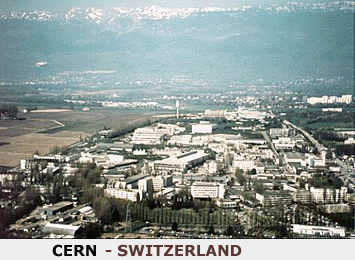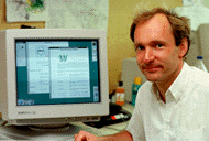The
World Wide Web (WWW) is so ubiquitous that it seems strange to think
that it has only been around for a few years. Indeed, use of the  WWW
became widespread in the mid 1990's, but its beginnings can actually
be traced back to 1980 when Tim Berners-Lee, an Englishman who had
recently graduated from Oxford, landed a temporary contract job as
a software consultant at CERN ( the famous European Particle physics
Laboratory in Geneva). He wrote a program, called Enquire, which he
called a "memory substitute," for his personal use to help him remember
connections between various people and projects at the lab (Wright,
64). This was a very helpful tool since CERN was (and still is)
a large international organization involving a multitude of researchers
located around the world.
WWW
became widespread in the mid 1990's, but its beginnings can actually
be traced back to 1980 when Tim Berners-Lee, an Englishman who had
recently graduated from Oxford, landed a temporary contract job as
a software consultant at CERN ( the famous European Particle physics
Laboratory in Geneva). He wrote a program, called Enquire, which he
called a "memory substitute," for his personal use to help him remember
connections between various people and projects at the lab (Wright,
64). This was a very helpful tool since CERN was (and still is)
a large international organization involving a multitude of researchers
located around the world.
Berners-Lee
finished his work at CERN and left, but he returned in 1984 with a
more permanent position. His previous work with Enquire had left a
mental mark. He envisioned a global information space where information
stored on computers everywhere was linked and available to anyone
anywhere. There were two technologies already developed that would
allow his vision to become reality. In 1945, Vannevar
Bush wrote an article entitled, "As
We May Think," in which he described a theoretical system for
storing information based on associations. Others like Ted
Nelson and Douglas Englebart had
furthered Bush's work with their own work on hypertext. Hypertext
allows documents to be published in a nonlinear format. Hypertext
links allow the reader to jump instantly from one electronic document
to another. Berners-Lee had already used this format when he wrote
Enquire.
The other technology was the Internet—a computer network
of networks. The Internet is a very general infrastructure that allows
computers to link together . It uses standardized protocols (TCP/IP)
which let computers of different types using different software communicate.
Hypertext would allow any document in the information space to be
linked to any other document. The Internet would allow those documents
to be transmitted.
At
CERN if researchers wanted to share documents they had to organize
and format them so that they would be compatible with the main CERN
computing system. This was a problem since the researchers contributing
to the work going on at CERN were located around the world and used
many different kinds of computers and software. Many researchers were
upset and sometimes unwilling to expend the extra effort to make their
work conform to the CERN system. Berners-Lee thought, " it would be
so much easier if everybody asking me questions all the time could
just read my database, and it would be so much nicer if I could find
out what these guys are doing by jumping into a similar database of
information for them" (Wright, 66).
He decided that a simple system with simple rules that would be acceptable
to all was needed. The new system would need to be easy and decentralized
so that anyone anywhere could share informationwithout having to go
to a centralized authority.
In
1989, Berners-Lee submitted a proposal at CERN to develop an information
system that would create a web of information. Initially, his proposal
received no reply, but he began working on his idea anyway. In 1990,
he wrote the Hypertext Transfer Protocol
(HTTP)—the language
computers would use to communicate hypertext documents over the Internet
and designed a scheme to give documents addresses on the Internet.
Berners-Lee called this address a Universal Resource Identifier (URI).
(This is now usually known as a URL—Uniform Resource Loc ator.)
By the end of the year he had also
ator.)
By the end of the year he had also
written a client program (browser) to retrieve and view hypertext
documents. He called this client "WorldWideWeb." Hypertext pages were
formatted using the Hypertext Markup Language (HTML) that Berners-Lee
had written. He also wrote the first web server. A web server is the
software that stores web pages on a computer and makes them available
to be accessed by others. Berners-Lee set up the first web server
known as "info.cern.ch." at CERN.
Berners-Lee tried to sell his new creation at CERN as a way to link
data between the many incompatible systems at CERN. Still the bureaucracy
at CERN was slow in acknowledging his efforts. Berners-Lee then turned
to the Internet community. In 1991, he made his WorldWideWeb browser
and web server software available on the Internet and posted notices
to several newsgroups including alt.hypertext. The Web began to take
off as computer enthusiasts around the world began setting up their
own web servers. Often the owners of the new sites would email Berners-Lee
and he would link to their sites from the CERN site. His dream of
a global information space was finally happening.
As
the number of users on the Web grew it became more attractive as a
medium. Scientists, who were already used to sharing information on
the Internet began to embrace the Web. It was easier to post information
on the Web once than reply repeatedly to multiple requests for the
same data. They also no longer had to worry whether or not the other
scientists used a different operating system. Government agencies
who had responsibilities to make their information public also began
turning toward the Web.
As
more people began using the Web the need for more point-and-click
browsers became evident. Berners-Lee had developed his WorldWideWeb
browser on a very specialized personal computer called a NeXT. What
was needed now was browser that Mac, PC, and Unix users could use.
This need was soon met as others, mostly students, began creating
new browsers. For instance, Students at the Helsinki University of
Technology wrote Erwise—a browser for Unix machines, and Pei
Wei, a U.C. Berkeley student wrote Viola. Colleagues of Berners-Lee
at CERN wrote a browser for Mac machines called Samba. Marc
Andreesen, a student at the University of Illinois, with the help
of fellow students, created the Mosaic browser.
Growth
of the Web and Potential Problems
New
browsers and the increasing amount of information that could be found
on t he
Web made it an ever more attractive medium. It grew exponentially,
both in the number of sites and users. The number of visitors to the
info.cern.ch server was growing by a factor of ten every year. By
the summer of 1993, the site was getting ten thousand hits a day (Berners-Lee,
75). Berners-Lee was predictably happy about the growth of his
brainchild, but various groups seemed to be going in opposite directions.
He feared that the Web would splinter into various factions—academic,
commercial, free, etc.
he
Web made it an ever more attractive medium. It grew exponentially,
both in the number of sites and users. The number of visitors to the
info.cern.ch server was growing by a factor of ten every year. By
the summer of 1993, the site was getting ten thousand hits a day (Berners-Lee,
75). Berners-Lee was predictably happy about the growth of his
brainchild, but various groups seemed to be going in opposite directions.
He feared that the Web would splinter into various factions—academic,
commercial, free, etc.
Berners-Lee
was concerned over some of the new directions the Web was taking.
There were decided differences between his original vision and the
visions of Andreesen and the Netscape crowd. The Web was designed
to be a serious medium. Berners-Lee feared that this new visually—appealing
Web was becoming frivolous. Berners-Lee and other HTML purists were
alarmed by all the new tags created by Netscape. Andreesen remembers,
" Tim bawled me out in the summer of '93 for adding images to the
thing," (Reid, 12).
World
Wide Web Consortium
Bern ers-Lee
was also concerned that the new success of the Web would lead to destructive
competition that would create proprietary Web products that could
destroy the open nature of the Web. He knew that some sort of oversight
was needed to keep the Web running smoothly, but any new oversight
organization could also not be allowed to fundamentally alter the
free and open character of the Web. He envisioned a forum where developers
of servers and browsers could reach a consensus on how the Web should
operate. On May 24, 1994, the first WWW conference was held at CERN.
Berners-Lee used this conference to share his vision to create a consortium
to help the Web develop smoothly: "The conference was the way to tell
everyone that no one should control it, and that a consortium could
help parties agree an how to work together while also actually withstanding
any effort by any institution or company to 'control' things." (Berners-Lee,
80).
ers-Lee
was also concerned that the new success of the Web would lead to destructive
competition that would create proprietary Web products that could
destroy the open nature of the Web. He knew that some sort of oversight
was needed to keep the Web running smoothly, but any new oversight
organization could also not be allowed to fundamentally alter the
free and open character of the Web. He envisioned a forum where developers
of servers and browsers could reach a consensus on how the Web should
operate. On May 24, 1994, the first WWW conference was held at CERN.
Berners-Lee used this conference to share his vision to create a consortium
to help the Web develop smoothly: "The conference was the way to tell
everyone that no one should control it, and that a consortium could
help parties agree an how to work together while also actually withstanding
any effort by any institution or company to 'control' things." (Berners-Lee,
80).
Berners-Lee
also discussed the idea of a consortium with some his friends at MIT.
In July of 1994 he received a phone call from one of those friends.
MIT agreed to host the consortium. MIT would be the American headquarters
and CERN would be the European headquarters. (CERN would later decide
to drop out of the consortium and France's National Institute for
Research in Computer Science and Control became the European headquarters).
Berners-Lee moved almost immediately to MIT to head the new consortium,
which was known as the World Wide Web consortium or simply W3C.
The
purpose of the new consortium was to " 'lead the Web to its full potential,'
primarily by developing common protocols to enhance the interoperability
and evolution of the Web." (Berners-Lee,
94). Membership in the consortium would be open to any organization:
commercial, governmental, educational, etc. Any member would be free
to participate in any meeting or working group put together by the
consortium.
The
W3C develops open technical specifications that can be used for free
by anyone. These specifications are reached by a very democratic process.
Any member can suggest a new project. If there is sufficient support
within the consortium the project proceeds. When it is finished it
is released by the consortium as a "recommendation." The W3C does
not enforce its recommendations. It simply encourages everyone to
adopt them.
 Vint
Cerf discusses his views on the WWW.
Vint
Cerf discusses his views on the WWW.
For
Further Reading
Weaving
the Web: The Original Design and Ultimate Destiny of the World Wide
Web by Tim Berners-Lee
How
the Web was Born: The Story of the World Wide Web
Tim
Berners-Lee and the Development of the World Wide Web (Unlocking the
Secrets of Science) For ages 9-12

Home|
Vannevar Bush | J.C.R.
Licklider | Larry Roberts | Paul
Baran |
Bob Metcalfe |
Doug Engelbart | Vint Cerf | Ted
Nelson | Tim Berners-Lee |
Marc Andreesen | Epilogue |
References |